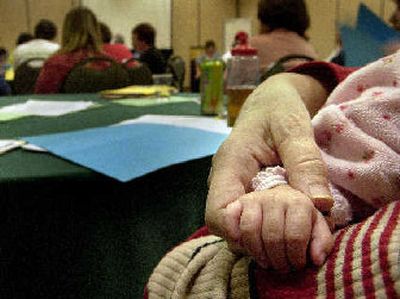Stuck between two worlds

The tiny leather moccasins – all 3 inches of them – sat on a table next to the 5-week-old girl.
Trudie Nesbitt, who has been a foster mother for nearly two decades, rocked the little girl in her arms.
“She’s already been to her first powwow,” said Nesbitt, who provides temporary foster care to medically fragile children.
Nesbitt is not a member of any tribe, but she has become an instrumental part of the state’s plan to care for Native American foster children, who have historically been overrepresented in Washington’s child welfare system. With a dearth of Indian foster homes, state social workers frequently place Native American children with non-Indian families.
“When these foster children are moved from place to place to place, they often have nothing to draw on,” said Chryss James, a state social worker and a member of the Tlingit tribe in Alaska. “Once they learn who they are, they can start to bridge the cultures.”
On Monday, state experts and foster parents in Spokane wrestled with how parents who may not be well-versed in Indian culture can provide appropriate care to Native American foster children.
The 1978 Indian Child Welfare Act gave tribes jurisdiction over their own children. Before that, Native American children living in dangerous homes were placed in foster care and, all too often, ties to their tribes were severed.
In a 1998 study, researchers found that Indian children placed in non-Indian homes faced a greater risk of psychological damage, but conceded that little research has been devoted to the topic. The children – whom the study termed “Split Feathers” – suffered both a loss of Native American culture and a more profound sense of isolation.
Today, researchers say the key is to educate non-Indian foster parents about Native American culture and history.
“I don’t want them to stay in my house and become white kids,” said Mary McGaughey, a foster mother to, among others, a Native American girl. “I want them to stay in my house and become who they are.”
The workshop – which covered a host of issues related to care-giving – was part of a three-day annual conference attended by some 500 foster parents and caregivers.
In the bewildering world of foster care, children can grow up without a strong sense of self, said James, the state social worker, who is caring for a 17-year-old boy.
Even those foster parents who are Native American can struggle with learning about the cultures and beliefs of a different tribe, James said. Her foster son is a member of a Washington tribe, forcing James to learn new customs, practices – even which foods are culturally significant.
“If the child sees you becoming involved and interested, they will follow,” James said.
Don Jensen, a 62-year-old music teacher from Aberdeen, Wash., and his wife, Rosala, adopted three Native American children.
Jensen, a member of the Cherokee tribe, and Rosala, who is not a tribal member, attempt to expose their children to a variety of cultures and encourage them to connect with their biological families.
“At their birthday parties, we say bring in all your relatives,” Jensen said. “Family is more important than anything.”
McGaughey, who described her heritage as “German, Irish, French and whatever,” said it was inevitable that children would learn some of the cultures of their caregivers.
“While I try not to force my beliefs on the children in my home, because they are in my home, they are going to pick up some of my culture,” she said.
For James, the exchange of ideas, as well as the preservation of culture, is crucial.
“I’m half Native American, and I’m half white,” James said. “I need both parts to be whole.”